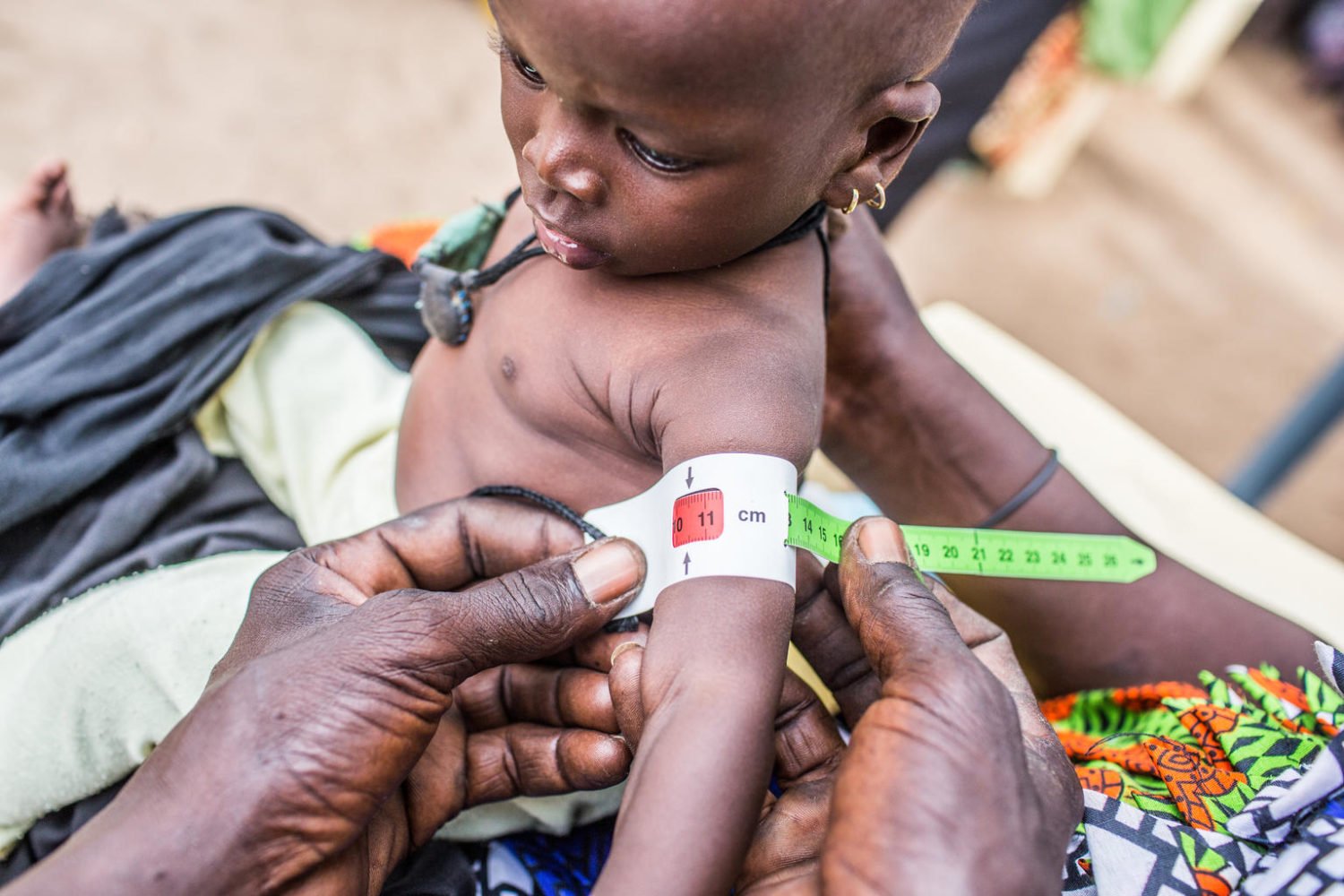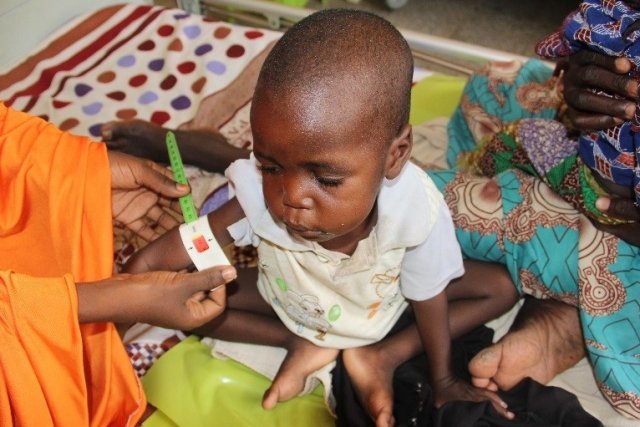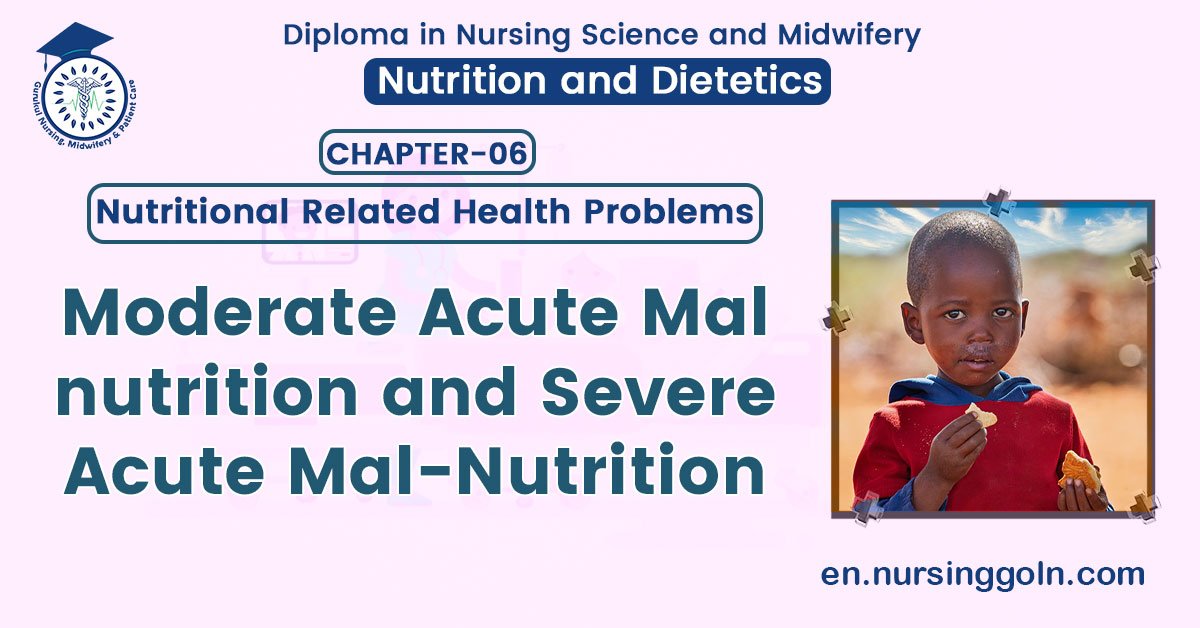Moderate Acute Mal – nutrition and Severe Acute Mal-Nutrition – This book covers the entire syllabus of “Nutrition and Dietetics” prescribed by BNMC-for all Diploma in Nursing Science and Midwifery students. We tried to accommodate latest information and topics. This book is examination friendly setup according to the teachers’ lectures and examination’s questions. At the end of the book previous university questions are given. We hope in touch with the book students’ knowledge will be upgraded and flourished. The unique way of presentation may make your reading of the book a pleasurable experience.
Moderate Acute Mal-nutrition and Severe Acute Mal-Nutrition
Types of Acute Malnutrition:
Moderate Acute Malnutrition
Moderate acute malnutrition (MAM), also known as wasting, is defined by a weight-for-height indicator between -3 and -2 z-scores (standard deviations) of the international standard or by a mid-upper arm circumference (MUAC) between 11 cm and 12.5 cm.

Severe Acute Malnutrition
Severe acute malnutrition (SAM) is another types of acute malnutrition and one the most dangerous forms. If left untreated, SAM can result in death. It can manifest in two ways:
Severe Wasting
Another type of acute malnutrition is severe wasting. This is characterized by a massive loss of body fat and muscle tissue. Children who are severely wasted look almost elderly and their bodies are extremely thin and skeletal.
Oedema
In this form of severe acute malnutrition, oedema is present on the lower limbs, and is verified when thumb pressure is applied on top of both feet for three seconds and leaves a pit or indentation in the foot, after the thumb is lifted. The oedema may eventually spread to the legs and face, and the child appears puffy, and is usually irritable, weak, and lethargic.
Causes of Malnutrition:
Primary malnutrition/primary cause of PEM:
1. Lack of food or means to have access to food
2. Lack of elementary knowledge of food and nutrition
3. Refusal to take food
4. Fat foods
5. Lack of teeth or inability to chew
Secondary malnutrition:
1. Disorders of the GIT.
2. Protracted immobilization
3. Fever
4. Surgery
5. Drug therapy
Preventive Measure of Malnutrition:
1. International level:
- Co-operation should be increased between the developed and underdeveloped countries for food.
- International agencies such as FAO, UNICEF, WHO are helping the government in different parts of the world against malnutrition.
2. National level:
- Population control.
- Increase in food production
- Rural development & Industrialization
- Proper storage and distribution of food.
3. Community level:
- Control of communicable diseases.
- Improvement of water supply.
- Health education
- Significant improvement of overall living conditions of the people.
4. Family level:
- Family spacing and planning.
- Special care for nursing mother and children.
- Breast feeding practice.
- Encouraging about poultry and vegetable garden
- Education regarding nutrition and home economics.
- Sanitation of homes.
- Standardization of living
Prevention of Malnutrition of a baby:
1. Promotion of breast feeding.
2. Low cost protein e.g. dhal.
3. Planning a. kitchen garden or keeping poultry.
4. Immunization against infectious diseases.
5. Family planning.
6. Nutritional education.
7. Consultation with the local doctor.

Ecological Factors Related to Malnutrition in Our Country:
Malnutrition is truly a man-made disease.
The ecological factors related to malnutrition are as follows:
2. Conditioning influences:
- Infectious disease responsible for malnutrition, particularly in small children. E.g. Diarrhoea, intestinal parasites, malaria etc.
3. Cultural influences:
- Food habits, customs, beliefs, traditions and attitudes,
- Religion,
- Food fads.
- Cooking practices.
- Child rearing practices.
- Miscellaneous:
✓ In some countries, men eat first and women eat last and poorly.
✓ Chronic alcoholism.
4. Socio-economic factors:
- Poverty
- Ignorance
- Insufficient education
- Lack of knowledge.
- Lack of knowledge regarding the nutritive value of foods
- Inadequate sanitary environment,
- Large family size.
5. Food production: Increased food production should lead to increased food consumption.
6. Health and other services:
- Nutritional surveillance,
- Nutritional rehabilitation,
- Nutrition supplementation
- Health education

WHO guide line for the management of severely malnourished children in the community (WHO, 2005):
1. Management of severe malnutrition children should usually have a community-based and a facility-based component. Children with no complications be treated in the community and with complications are referred to an inpatient treatment facility with trained staff.
2. Children with no complications, alert, have good appetite, are clinically well, are not oedematous, and have reasonable homecare circumstances.
3. Children having mild or moderate oedema and good appetite but are not severely wasted severely can also be treated at home.
4. Severe malnutrition and complications cases should be referred to an inpatient treatment facility with trained staff. Children with anorexia, with severe oedema, both severe wasting (MUAC <110 mm or WFH <70% or <-3 Z of NCHS /WHO reference) and, mild or moderate oedema, or clinically unwell.
5. In inpatients, after the complications of severe malnutrition are under control, management should normally be continued in the community. Children who deteriorate at home should be referred for assessment and further management.
6. To treat cases without complications in communities with limited access to appropriate local diets for nutritional rehabilitation.
7. Children should get 150-220 kcal/kg/day.
8. When families have access to nutrient-dense foods, severe malnutrition without complications can be managed by means of carefully designed diets using low cost family foods, provided appropriate minerals and vitamins are given.
9. Efficacy of local therapeutic diets should be tested clinically.
10. Treatment of U2 children should include support for breastfeeding and messages on appropriate infant and young children feeding practices.
11. Children < 6m need milk-based diets and their mothers support to re-establish breastfeeding. They should not be treated at home.
12. Monitoring of effectiveness of treatment should be based on weight gain of at least 5 g/kg/day for severely wasted children, low case fatality, defaulting and treatment failures, and length of stay under treatment.

Read more:
